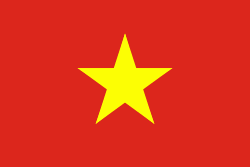Tuyen Quang province (Tỉnh Tuyên Quang)
Tuyên Quang borders Hà Giang to the north, Cao Bằng to the northeast, Bắc Kạn and Thái Nguyên to the east, Vĩnh Phúc to the south, Phú Thọ to the southwest, and Yên Bái to the west.
Tuyên Quang, the capital city of the province has a rich history of the battles fought in the region. The earliest history is to the First Indochina War when it served as a garrison. During this war the Viet Minh made the Legionnaires surrender at the memorial to the Battle of Tuyên Quang. Another historical event is the Siege of Tuyên Quang, commemorated in the first verse of Le Boudin, its principal marching song. The French garrison posted at Tuyên Quang defended the town for four months against 12,000 troops of the Yunnan Army and the Black Flag Army. Two companies of the French Foreign Legion1 company of Tonkinese Tirailleurs, 31 naval gunners with four mountain guns, and eight sappers, commanded by Sergeant Bobillot, plus the gunboat Mitrailleuse. were involved during the Sino-French War (August 1884 to April 1885).
Tuyên Quang was once entirely settled by Thai people, but from the 13th century onwards were integrated into the Trần dynasty, who named it Quốc Oai before naming it Châu Tuyên Quang. Under the rule of Emperor Trần Hiến Tông (reigned 1329–1341), Tuyên Quang was given the status of a trấn, before being categorised as thành phủ when the Ming dynasty of China briefly annexed Vietnam at the start of the 15th century. After Lê Lợi expelled the Chinese and started the Lê dynasty, he made Tuyên Hóa a part of Tây Đạo. During the reign of Emperor Lê Thánh Tông, Tuyên Quang comprised one phủ and five districts (huyện) and became the province of Minh Quang under the rule of Emperor Lê Uy Mục. During the reign of Lê Trang Tông, Minh Quang became An Tại, and control of the region was given to the Vũ family, ethnic Thai people.
By the end of the 17th century, the Lê dynasty sent ethnic Vietnamese officials to the area to supervise the Thais. After Gia Long started the Nguyễn dynasty, he changed the region to the trấn of Tuyên Quang, and it became a province under the rule of his successor Emperor Minh Mạng. When the French carried out their colonial conquest, the phủ of Yên Bình was at the forefront of the resistance movement. People from the Thái, Mường, Mèo, Thổ, Nùng and another ethnic groups engaged the French in many battles in the area in 1884–1885. The Black Flags were also prominent. It was not until 1894 that the French had pacified the region. Prior to 1975, the province comprised the districts of Yên Sơn, Yên Bình, Hàm Yên, Sơn Dương, Chiêm Hóa and Đại Thi.
Map - Tuyen Quang province (Tỉnh Tuyên Quang)
Map
Country - Vietnam
 |
 |
| Flag of Vietnam | |
Vietnam was inhabited by the Paleolithic age, with states established in the first millennium BC on the Red River Delta in modern-day northern Vietnam. The Han dynasty annexed Northern and Central Vietnam under Chinese rule from 111 BC, until the first dynasty emerged in 939. Successive monarchical dynasties absorbed Chinese influences through Confucianism and Buddhism, and expanded southward to the Mekong Delta, conquering Champa. The Nguyễn—the last imperial dynasty—surrendered to France in 1883. Following the August Revolution, the nationalist Viet Minh under the leadership of communist revolutionary Ho Chi Minh proclaimed independence from France in 1945.
Currency / Language
| ISO | Currency | Symbol | Significant figures |
|---|---|---|---|
| VND | Vietnamese đồng | ₫ | 0 |
| ISO | Language |
|---|---|
| KM | Central Khmer language |
| ZH | Chinese language |
| EN | English language |
| FR | French language |
| VI | Vietnamese language |















